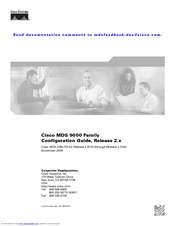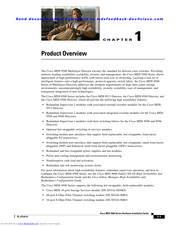Cisco MDS 9506 Director Multilayer Switch Manuals
Manuals and User Guides for Cisco MDS 9506 Director Multilayer Switch. We have 2 Cisco MDS 9506 Director Multilayer Switch manuals available for free PDF download: Configuration Manual, Overview
Cisco MDS 9506 Director Configuration Manual (1096 pages)
MDS 9000 Family
Brand: Cisco
|
Category: Network Hardware
|
Size: 12 MB
Table of Contents
-
-
Trunking68
-
Portchannels68
-
-
IP Services
68-
Ficon69
-
Rlir69
-
IP Storage69
-
Call Home70
-
-
-
-
Moving Files100
-
Copying Files101
-
Deleting Files101
-
-
-
Licensing Model109
-
-
-
Configuring CDP152
-
-
About CFS160
-
CFS Features161
-
CFS Protocol161
-
-
Default Settings170
-
-
-
-
Quick Upgrade195
-
-
-
-
About Modules241
-
-
-
Services Modules243
-
-
-
-
-
Auto Mode286
-
-
-
Reason Codes287
-
-
Interface Modes290
-
Beacon Mode297
-
-
About Speed Leds298
-
-
-
Configuring CIM302
-
-
-
-
Default Settings344
-
-
Domain Restart347
-
Switch Priority350
-
Fabric Name352
-
-
Default Settings371
-
-
VSAN Advantages375
-
How Vsans Work376
-
-
Default VSAN379
-
Isolated VSAN379
-
-
VSAN Attributes380
-
VSAN Membership380
-
-
-
About DPVM386
-
Enabling DPVM386
-
-
Default Settings396
-
About IVR398
-
IVR Features399
-
-
-
-
IVR Terminology399
-
IVR Guidelines400
-
Enabling IVR402
-
Enabling IVR NAT406
-
-
-
Zoning Features434
-
Zoning Example435
-
Zone Enforcement442
-
The Default Zone443
-
-
About LUN Zoning449
-
-
Default Settings468
-
-
-
FSPF Features480
-
-
FSPF Examples480
-
-
-
Displaying FDMI505
-
-
About FICON518
-
Port Addresses524
-
FC ID Allocation526
-
FICON Cascading526
-
Enabling FICON527
-
Port Swapping541
-
-
-
Default Settings565
-
-
-
-
-
-
SNMP Security606
-
Default Settings619
-
-
-
-
Authentication622
-
-
Authorization623
-
Accounting623
-
Server Groups624
-
-
-
-
Filter Contents650
-
Port Information651
-
ICMP Information652
-
TOS Information652
-
IP-ACL Creation653
-
-
-
About Ipsec660
-
About IKE661
-
Initializing IKE665
-
Refreshing Sas669
-
-
Crypto Acls669
-
-
-
Default Settings694
-
-
-
-
About DHCHAP697
-
-
-
About FCIP728
-
FCIP Links729
-
FCIP Profiles730
-
FCIP Interfaces730
-
Enabling FCIP730
-
-
-
Path Mtus735
-
Buffer Size737
-
Peer IP Address739
-
Special Frames739
-
-
-
Fspf757
-
Vrrp757
-
Default Settings759
-
-
Advertisement

